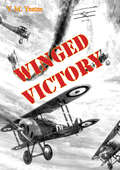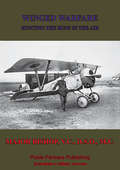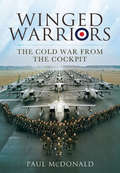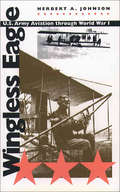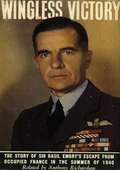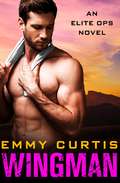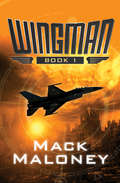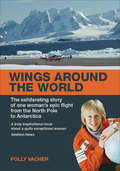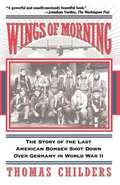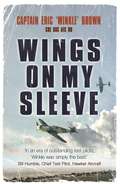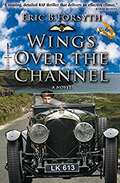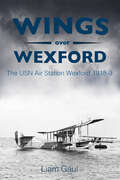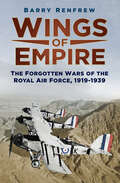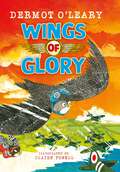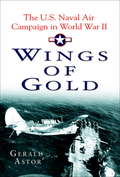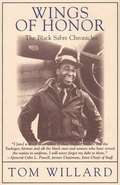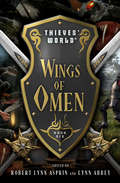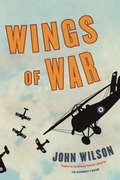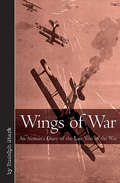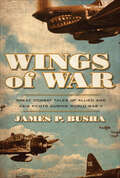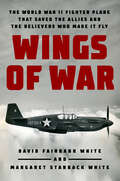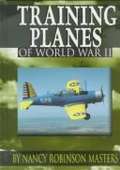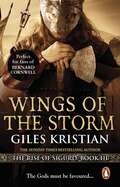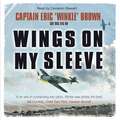- Table View
- List View
Winged Victory [Illustrated Edition]
by V. M. YeatesIncludes Aerial Warfare During World War I Illustrations Pack with 115 maps, plans, and photos."There is no bitter snarl nor self-pity in this classic novel about the air war of 1914-1918, based very largely on the author's experiences. Combat, loneliness, fatigue, fear, comradeship, women, excitement -- all are built into a vigorous and authentic structure by one of the most valiant pilots of the then Royal Flying Corps.REVIEWS'The greatest novel of war in the air.'--Daily Mail'Beautifully written with a poet's eye as well as a pilot's eye.'-- Southern Evening Echo'The only book about flying that isn't flannel.'--Anonymous Fighter Pilot'Not only one of the best war books...but as a transcription of reality, faithful and sustained in its author's purpose of re-creating the past life he knew, it is unique.'--Henry Williamson, author of Tarka the Otter."-Print ed.
Winged Warfare - Hunting The Huns In The Air [Illustrated Edition]
by Major Billy Bishop V.C. D.S.O. M.C.[Illustrated with 17 additional photos of the author and the machines he flew and fought against]As a young Billy Bishop looking up into the sky above his Canadian trench in July 1915, a passing Royal Flying Corps aircraft was returning home from patrol. He was envious and said to whoever was listening "...it's clean up there! I'll bet you don't get any mud or horse **** on you up there. If you die, at least it would be a clean death.". Struck by his sudden epiphany he requested a transfer to the Royal Flying Corps, it was a momentous decision, for within the next three years Bishop would claim 72 victories over his German opponents, making him the highest scoring British Empire air ace of the First World War.A National Hero in his native Canada, he was awarded a V.C. for conspicuous services - the citation read:"For most conspicuous bravery, determination, and skill. Captain Bishop,...[On his own] flew first of all to an enemy aerodrome; finding no machines about, he flew on to another aerodrome...which was at least 12 miles the other side of the line. Seven machines....were on the ground. He attacked these from about fifty feet...One of the machines got off the ground, but at a height of 60 feet, Captain Bishop fired 15 rounds into it at very close range, and it crashed to the ground. A second machine got off the ground, into which he fired 30 rounds at 150 yards range, and it fell into a tree. Two more machines then rose from the aerodrome. One of these he engaged at a height of 1,000 feet, emptying the rest of his drum of ammunition. This machine crashed 300 yards from the aerodrome, after which Captain Bishop emptied a whole drum into the fourth hostile machine, and then flew back to his station. Four hostile scouts were about 1,250 feet above him for about a mile of his return journey, but they would not attack. His machine was very badly shot about by machine gun fire from the ground."A fine memoir from an Air Ace legend.
Winged Warriors: The Cold War from the Cockpit
by Thomas McDonaldPaul McDonald is a former RAF fast-jet pilot whose flying career spanned 34 years. He is not a typical senior RAF officer having been brought up on a council estate in a bleak northern industrial town. He became a pilot by accident and struggled to gain his wings. He spent 14 years on operational tours overseas including 2 tours at the height of the Cold War on a Tornado tactical nuclear squadron in Germany, only 15 minutes from responding to an anticipated Soviet onslaught. Earlier he served on a low-level photo reconnaissance squadron on NATO's vulnerable southern flank. He was decorated for gallantry in 1980 and later served in Kuwait as the Senior RAF Adviser, including Operation Desert Fox, the air war against Iraq in 1998.
Wingless Eagle
by Herbert A. JohnsonAt the start of the twentieth century the United States led the world in advances in aviation, with the first successful engine-powered flights at Kitty Hawk, North Carolina, and Dayton, Ohio, beginning in 1903. Fifteen years later, however, American airmen flew European-designed aircraft because American planes were woefully inadequate for service on the Western Front. Why was the United States so poorly prepared to engage in aerial combat in World War I? To answer this question, Herbert Johnson takes a hard look at the early years of U.S. military aviation, exploring the cultural, technical, political, and organizational factors that stunted its evolution. Among the recurring themes of Johnson's narrative are the damaging effects of a chronic lack of governmental funding for military aeronautics and the disruptive influence of a civilian "aeronaut constituency" both on military discipline and on public and Congressional attitudes toward army aviation. In addition, the Wright brothers' patent litigation hindered the technical development of American aircraft and crippled the domestic aviation industry's manufacturing capacity. Wartime experience helped correct some of these problems, but the persistence of others left the postwar Air Service with an uncertain and stormy future.
Wingless Victory: The Story of Sir Basil Embry’s Escape from Occupied France in the Summer of 1940
by Anthony RichardsonWINGLESS VICTORY is the story of an audacious and desperate man on the run, the record of one of the first wartime escapes through Occupied France. It reads like a first-class thriller and, as one critic puts it, "leaves fiction gasping far behind." On May 27, 1940, Wing-Commander Basil Embry (later Air Chief Marshal Sir Basil Embry, and Commander, Allied Air Forces in Central Europe 1953-56), although appointed to a higher command, decided to lead his old squadron into battle for the last time. Within the hour he was shot down in France and found himself alone, unarmed, and in uniform. Capture was inevitable. He was, in fact, captured three times, but refused to submit. Once he broke from a column of prisoners under the muzzle of a German machine-gun. Another time he fought his way out, killing three Germans with a stolen rifle and then hiding in a manure heap for nearly six hours. But perhaps the most amazing of all his exploits was the occasion on which, in the role of a fanatical member of the Irish Republican Army, he shook his fist under the nose of a German inquisitor, yelling hatred and abuse of Britain until his captors finally turned him loose to find his own way home. At this period there was little of escape technique to guide him and he had no opportunity to lay plans or prepare equipment. Yet, by sheer courage and wit, he found his way back to Britain to fight and fly again. He won the D.S.O. and three bars, and the D.F.C."The author succeeds in communicating vividly, yet unpretentiously, the sensations of a man on the run....About ten times as exciting as a fictional thriller."--Sunday Times"A thrilling and authentic escape story--will prove a classic."--Daily Herald"The records of World War II have no wilder or stranger story to tell."--Tatler"It is an extremely exciting story, but well spiced with humour as well."--Illustrated London News
Wingman (Elite Ops #2)
by Emmy CurtisSizzling hot and full of action, the Elite Ops military romance series is perfect for fans of Suzanne Brockmann, Julie Ann Walker, and Lynne Ray Harris.The higher the risk, the harder the fall.Maj. Missy Malden loves her job, her plane, and its pilot-not that she could ever let him know. He's way too cocky, way too sexy, and in their job, any distraction is way too dangerous. But when a training exercise spirals out of control, Missy's in the hot seat, and Conrad's the only one who can bail her out . . . Lt. Col. Francis Conrad has always valued Missy too much as his weapons specialist to ever tell her how he really feels. But now that she's been accused of treason, he can't sit back and let her fly solo. To keep her safe, he'll put everything on the line-his career, his heart, and even his life.
Wingman: The Tomorrow War (Wingman #1)
by Mack MaloneyThe first book in the bestselling, action-packed Wingman Series: With America in ashes, and lawlessness threatening to rule land, air, and sea, one pilot stands poised to pull his nation back from the brink of all-out anarchy The Big War started in Western Europe with a Soviet nerve gas attack that laid waste to France, Germany, and Spain. The world&’s democracies fought back, and pilots like Hawk Hunter led the charge—tearing across the flaming wreckage of the continent at supersonic speeds. They pushed the Russians back and just when victory was in sight, a traitor at the highest level of government turned off America&’s missile defense system, and Soviet nukes rained from the sky. Two years after the nuclear holocaust, Hunter gets a message to report to his old commander. America is in pieces: Pirates rule the skies, and an airborne armada is plotting to attack Football City (formerly known as St. Louis). The armada is made up of criminals flying state-of-the-art jets, and even though the government can only offer Hunter his old F-16, he will do whatever it takes to reclaim his ravaged homeland. Wingman is the first book of the Wingman series, which also includes The Circle War and The Lucifer Crusade.
Wings Around the World: The Exhilarating Story of One Woman's Epic Flight From the North Pole to Antarctica
by Polly VacherOn May 6, 2003, Polly Vacher took off from Birmingham airport seeking to become the first pilot to complete a solo flight around the world via both Poles in a single-engine aircraft. Despite having only a few years of flying experience, Polly, a 59-year-old mother of three, had already completed a lateral solo circumnavigation of the world in 2001 for the charity Flying Scholarships for the Disabled; this second challenge, for the same charity, would make that achievement look like a casual jaunt. There would be no margin for error. Her voyage to the ice was a 35,000-mile adventure in her Piper Dakota that would take her to at least 30 different countries on every single continent. She had prepared meticulously for two years, was fully insured and had all the requisite permits and visas. With her kinetic enthusiasm, charm and persistence, she had already garnered multifarious sponsors ranging from multinationals such as Shell to private individuals. However, as she took off on that blustery spring day, flanked by a Hurricane and a Spitfire from the RAF Battle of Britain Flight, and waved off by her family and the Prince of Wales, she suddenly felt so alone. She had begun a remarkable expedition that would gain her three world records, but would also see her encounter extremes of weather and emotion, much kindness and obstruction and also a little political intrigue.
Wings Of Morning: The Story Of The Last American Bomber Shot Down Over Germany In World War II
by Thomas ChildersOn April 21, 1945, the twelve-member crew of the Black Cat set off on one of the last air missions in the European theater of World War II. Ten never came back. This is the story of that crew—where they came from, how they trained, what it was like to fly a B-24 through enemy flak, and who was waiting for them to come home. <P><P>Historian Thomas Childers, nephew of the Black Cat's radio operator, has reconstructed the lives and tragic deaths of these men through their letters home and through in-depth interviews, both with their families and with German villagers who lived near the crash site. In so doing he unearths confusion about the exact number of crash survivors and ugly rumors of their fate at the hands of the German villagers. His search to determine what really happened leads him to the crash site outside of Regensburg to lay the mystery to rest.In the tradition of Young Men and Fire, Wings of Morning is history as commemoration-an evocation of people and events that brings to life a story of love, loss, and a family's quest for truth.
Wings On My Sleeve: The World's Greatest Test Pilot tells his story
by Eric BrownThe autobiography of one of the greatest pilots in history.In 1939 Eric Brown was on a University of Edinburgh exchange course in Germany, and the first he knew of the war was when the Gestapo came to arrest him. They released him, not realising he was a pilot in the RAF volunteer reserve: and the rest is history. Eric Brown joined the Fleet Air Arm and went on to be the greatest test pilot in history, flying more different aircraft types than anyone else. During his lifetime he made a record-breaking 2,407 aircraft carrier landings and survived eleven plane crashes. One of Britain's few German-speaking airmen, he went to Germany in 1945 to test the Nazi jets, interviewing (among others) Hermann Goering and Hanna Reitsch. He flew the suicidally dangerous Me 163 rocket plane, and tested the first British jets. WINGS ON MY SLEEVE is 'Winkle' Brown's incredible story.
Wings Over The Channel
by Eric ForsythWings Over the Channel follows the continuing adventures of Allan Chadwick, a young RAF pilot who completed his tour in Iraq and is now posted to the RAF aviation research center at Farnborough in southern England. It is the mid-1930s and Britain is threatened by belligerent countries such as Nazi Germany and Fascist Italy. The rapid development of high-speed bombers negates the centuries-old isolation that Britain enjoyed as an island. <P><P> Chadwick is involved in the RAF’s frantic effort to build an effective radar screen, and uses an early model Spitfire for liaison with outlying radar stations, flying in fair weather or foul, as he contends with the idiosyncrasies of the prototype fighter. Closer to earth he drives an old, monstrous Bentley, which attracts attention wherever he goes. He falls in love with an older, aristocratic widow who supports a secretive upper-class appeasement clique which, unbeknownst to them, has been compromised by the German Abwehr <P><P> British Intelligence decides it is impossible to keep the existence of radar a secret from the German Luftwaffe, but its effectiveness is downplayed in misleading reports fed to the Germans by Chadwick. The success of the deception—and Chadwick’s life— are threatened when an accurate report of radar performance is stolen by a German spy.
Wings Over Wexford: The USN Air Station Wexford 1918-19
by Liam GaulIn 1918, during the final year of the First World War, the USN had a force of over 400 sailors and 22 officers and 4 Curtiss H16 seaplanes based in at Ferrybank, Wexford. The base was a veritable village with accommodation, hospital, medics, post office, YMCA Hall, radio towers, electricity generating plant and very large aircraft hangers. Although only operational for a limited period, its impact on the town of Wexford was considerable and its achievements in the global conflict were significant, protecting shipping, both naval and commercial, from the German u-boats. To mark the impending 100-year anniversary of this base, this book by local historian Liam Gaul recalls this often-overlooked aspect of Ireland’s involvement in the First World War.
Wings of Empire: The Forgotten Wars of the Royal Air Force, 1919-1939
by Barry RenfrewAt the end of the First World War, British power in the colonies was at an all-time low. That was until a ragtag band of visionaries, including Winston Churchill and T.E. Lawrence, proposed that the aeroplane, the wonder weapon of the age, could save the empire. Using the radical strategy of air control, the RAF tried to subdue vast swathes of the Middle East, Asia and Africa. Wings of Empire is a compelling account of the colonial air campaigns that saw a generation of young airmen take to the skies to battle against warlords, jihadists and hostile tribes. For the first time ever, this book chronicles the full story of the RAF’s most extraordinary conflict.
Wings of Glory: An amazing wartime action-adventure story for readers aged 8+ from the author of Toto the Ninja Cat (Wartime Tails)
by Dermot O’LearyCan one tiny bird help to win a world war? Wings of Glory is a funny action-adventure story with a feathery twist, from the bestselling children's author of Toto the Ninja Cat, Dermot O'Leary, with glorious illustrations throughout by Claire Powell.It's 1940, and the world is at war. Linus, a swift, has always dreamed of flying with the Royal Bird Force and making a name for himself as a squadron leader. So when he and his sister, Ava, have the opportunity to volunteer, he jumps at the chance.But it's a dangerous journey, and Ava goes missing before they manage to reach the airfield for training. Now, Linus has two missions: help the war effort and find his sister.Linus will face bomber planes, arrogant falcons, and a spy who's determined to take him down...He is brave and fast and kind - but can Linus prove that helping win the war is more about the size of your heart than the size of your wings?Featuring courageous loop-the-loops, top secret plans and more than a smattering of bird poo, this wartime tail will make you laugh and cry - and maybe teach you a thing or two as well.
Wings of Gold: The U.S. Naval Air Campaign in World War II
by Gerald AstorFrom critically acclaimed military historian Gerald Astor comes Wings of Gold, the first account of how the airplane transformed the U. S. Navy and paved the way to victory in the Pacific in World War II. Astor tracks that fateful journey from its humble beginnings in 1910 when Eugene Ely flew the very first plane off the deck of a U. S. Navy ship to the unprecedented air combat missions that helped defeat the Japanese. Few naval aviators in World War II realized that when they earned their wings of gold they were about to become test pilots for a whole new kind of combat. In their own words, these courageous fliers describe the life-and-death air battles that defined the revolution in naval strategy that rose from the ashes of Pearl Harbor, when fighter pilots watched in horror as Japanese carrier-launched aircraft bombed their planes and airfields into smoking rubble. While following the pilots' firsthand reports of air strikes and blazing dogfights across the islands and atolls of the Pacific, Astor explores the ways the U. S. Navy began its momentous transformation before the war. Later, the critical role of aircraft carriers in the stunning U. S. victory at Midway sounded the death knell for conventional naval warfare, yet the public, the press, the Army, and even the president's advisors refused to recognize the new reality. In fact, only a few in the Navy understood that a new era had begun that would change the face of war forever. The young Americans who fought the deadly duels against Imperial Japanese forces high over the Pacific gave everything they had to the war effort, and many made the supreme sacrifice. Wings of Gold pays tribute to their courage, daring, and selfless dedication. Vividly told, thoroughly researched, and filled with stirring accounts of the Pacific War's greatest air battles, Wings of Gold is an important addition to the annals of World War II aerial combat.
Wings of Honor (Black Sabre #3)
by Tom WillardIn World War Two, for the first time in American military history, black men were trained as combat pilots and sent into the air war over Europe. The training took place at The Tuskegee Institute in Alabama and those who were awarded their wings there were ever after known as the Tuskegee Airmen. In Wings of Honor, veteran novelist Tom Willard (The Buffalo Soldiers, The Sable Doughboys) tells the story of Augustus Sharps, Jr., a young black man born to the military life who takes down the battered sabre his father and grandfather carried to battle in other wars and against incredible odds, becomes a member of the all-Negro 99th Pursuit Squadron -- the "Red-Tail Angels" -- flying P-40 Warhawks and P-51 Mustangs over North Africa, Sicily, and France. This is the story, both poignant and exciting, of a third-generation fighting man who fights the war against bigotry at home in order to fight his country's enemies abroad.
Wings of Omen: Storm Season, The Face Of Chaos, And Wings Of Omen (Thieves' World® #6)
by John Brunner Joe Haldeman Philip José FarmerSixth in the magical, action-packed shared-world series: &“Thieves&’ World® has grown into a real presence in the fantasy genre&” (Fantasy-Faction). Under the rule of a humanoid race, the city of Sanctuary finds itself divided. Rebels and assassins stalk the shadows, bringing chaos to the streets—which is nothing new to the lawless locals. But even they will have to put aside their differences to unite against their common enemy. An accomplishment easier said than done in a city where everyone is out for themselves . . . Stories by Chris and Janet Morris, Robin W. Bailey, Diana L. Paxson, Diane Duane, C. J. Cherryh, Andrew J. Offutt, Lynn Abbey, and Robert Lynn Asprin add to the legend and lore of this &“surprisingly rich and deep world&” (Book Riot). &“In the sixth book of the collection, the friction between the residents of Sanctuary and the invading Beysib heats up and makes for some exciting reading . . . Offutt&’s character Shadowspawn gets some good coverage, and a few fresh new characters also get some play . . .&” —Fantasy-Faction &“&‘The Hand That Feeds You&’ [by Diane Duane] is one of the best stories in the entire collection to date.&” —brianbookreviews.blogspot.com
Wings of War
by John WilsonA boy-friendly book set during World War One, published for the centennary of the war and accompanied by a digital component to boost interest from the school and library market. It's the early 1900s and Edward Setten is growing up in the prairies fascinated by his uncle, who is one of the very first people in Canada to pilot a plane. Despite his mother's protests, Edward learns to fly and, when war breaks out, joins the Royal Flying Corps. In this fast-paced and gripping novel, Edward's coming of age takes place in the most extraordinary of circumstances.
Wings of War: An Airman's Diary of the Last Year of the War (Vintage Aviation Library)
by Rudolf StarkA rare day-to-day account by a young German squadron leader in Jagdstaffel 35 during the grim last year of World War I. Originally published in 1933, Wings of War provides minute descriptions of kills, losses, and the Germans&’ step-by-step retreat in the face of increasingly overwhelming Allied forces in the air. Brutally honest and vividly written, Rudolf Stark&’s account of the endgame of the Imperial German Army Air Service provides an intimate, front-row glimpse of the death-throes of a once-feared corps. This book also contains reproductions of some of the author&’s paintings depicting life on the Western Front. &“A work of depth and insight, illustrated with the author&’s own photographs and paintings from a cockpit perspective . . . League members are highly encouraged to read this classic of aviation history literature.&” —Over the Front &“Provides a thoughtful look at the decline of Germany, its military, and its air force in the last half of 1918.&” —World War One Illustrated
Wings of War: Great Combat Tales of Allied and Axis Pilots During World War II
by James P. BushaExperience the exciting combat tales of both Allied and Axis pilots around the world during World War II.Wings of War encompasses the World War II air war from late 1939 through 1945 and provides a chronological snapshot not only of famous and significant events from the global air war, but also of other lesser-known events that are equally thrilling and important. Over three dozen different Allied and Axis airplanes are featured, giving you a unique experience at the controls of a variety of World War II’s famed fighters, bombers, liaison, and jet airplanes.Here are just a few of the stories included about World War II aces from author Jim Busha’s vast archival research and interviews: ·A pilot that flew a P-36 against the Japanese at Pearl Harbor on December 7, 1941, while still in his Sunday pajamas. ·A B-25 pilot who launched off the USS Hornet along with his fellow Doolittle Raiders. ·P-40 pilots who flew against Rommel and his Afrika Korps. ·A PBY pilot helped locate and recover a downed Zero over the Aleutians, which was later used as a test bed to learn its deadly tricks. The action is truly global—from the skies over England, Greenland, mainland Europe, the African deserts, the CBI Theater, the entire Pacific Theater (including the Aleutians, Russia, Japan, and China), and many more—this is one book no fan of warbirds will want to miss!
Wings of War: The World War II Fighter Plane that Saved the Allies and the Believers Who Made It Fly
by David Fairbank White Margaret Stanback WhiteThe incredible, untold story behind the rise of the P-51 Mustang, the World War II fighter plane that destroyed the Luftwaffe and made D-Day possible&“Aviation buffs will cheer this high-flying saga.&”—Publishers Weekly • &“[A] fascinating book about passion and innovation.&”—Walter Isaacson • &“An essential book for those who appreciate tales of military bravery, and also for all seeking understanding of decision-making under pressure. A major contribution.&”—E. J. Dionne, Jr.When the P-51 Mustang began tearing across European skies in early 1944, the Allies had been losing the air war for years. Staggering numbers of bomber crews, both British and American, had been shot down and killed thanks to the Luftwaffe&’s superior fighter force. Not only did the air war appear grim, but any landing of troops in France was impossible while German fighters hunted overhead. But behind the scenes, a team of visionaries had begun to design a bold new type of airplane, one that could outrun and outmaneuver Germany&’s best. Wings of War is the incredible true story of the P-51 Mustang fighter and the unlikely crew of designers, engineers, test pilots, and army officers who brought it from the drafting table to the skies over World War II. This is hardly a straightforward tale of building an airplane—for years, the team was stymied by corruption within the defense industry and stonewalled by the Army Air Forces, who failed to understand the Mustang&’s potential. But when squadrons of Mustangs were finally unleashed over Hitler&’s empire, the Luftwaffe was decimated within months, clearing the skies for D-Day. A compelling, character-focused narrative replete with innovation, determination, and bravery, Wings of War is the never-before-told story of the airplane that truly changed the course of World War II.
Wings of War: Training Planes of World War II
by Nancy Robinson Masters Nancy Robinson-MastersIntroduces the various kinds of World War Two trainer planes, describes the missions for which they were used, and sketches the training required of their pilots. Also discusses what some of the airplanes were used for after World War 2.
Wings of the Storm: (The Rise of Sigurd 3): An all-action, gripping Viking saga from bestselling author Giles Kristian (Sigurd #3)
by Giles KristianA Viking saga of warmongering, honour and loyalty from the Sunday Times bestselling author of Lancelot, Giles Kristian. Perfect for fans of Bernard Cornwell and Games of Thrones."A fitting end to a trilogy that fans of Bernard Cornwell should devour" -- THE TIMES"The master storyteller...whose books throw the reader headlong into the Viking age." -- BEN KANE"This remains Viking writing at its best: thrilling in it truest sense, heart-rendering and, yes, glorious." -- MANDA SCOTT"Probably the best Viking saga I have ever read -- ***** Reader review "Wonderfully written and researched, the whole series makes the entire Nordic world come alive" -- ***** Reader review"This trilogy is gripping from start to finish" -- ***** Reader review*****************************************THE GODS MUST BE FAVOURED...Norway, AD 785. A wild place, a place of blood, a place where the gods hold sway . . .Sigurd Haraldarson and his oathsworn band are winning fame and reputation. But to confront his hated enemy - the oath-breaker and betrayer King Gorm - they must win riches too.When a daring raid goes wrong, Sigurd finds himself a prisoner of the powerful Jarl Guthrum. Bound like a slave, he is taken to the sacred temple at Ubsola to face the sacrificial knife.But here Sigurd discovers a potent relic: Gungnir, a great spear that would give him the power to assemble a host strong enough to challenge King Gorm, and avenge the betrayal of his father and the murder of his family.The roar of Odin and the wild hunt will be as nothing compared to Sigurd's rage, for he and his warriors will be borne on the wings of the storm . . .Wings of the Storm concludes the Viking saga, started in God of Vengeance and Winter's Fire.
Wings on My Sleeve: The World's Greatest Test Pilot tells his story
by Captain Eric BrownThe autobiography of one of the greatest pilots in history.In 1939 Eric Brown was on a University of Edinburgh exchange course in Germany, and the first he knew of the war was when the Gestapo came to arrest him. They released him, not realising he was a pilot in the RAF volunteer reserve: and the rest is history. Eric Brown joined the Fleet Air Arm and went on to be the greatest test pilot in history, flying more different aircraft types than anyone else. During his lifetime he made a record-breaking 2,407 aircraft carrier landings and survived eleven plane crashes. One of Britain's few German-speaking airmen, he went to Germany in 1945 to test the Nazi jets, interviewing (among others) Hermann Goering and Hanna Reitsch. He flew the suicidally dangerous Me 163 rocket plane, and tested the first British jets. WINGS ON MY SLEEVE is 'Winkle' Brown's incredible story.
Wings on My Sleeve: The World's Greatest Test Pilot tells his story
by Captain Eric BrownThe autobiography of one of the greatest pilots in history.In 1939 Eric Brown was on a University of Edinburgh exchange course in Germany, and the first he knew of the war was when the Gestapo came to arrest him. They released him, not realising he was a pilot in the RAF volunteer reserve: and the rest is history. Eric Brown joined the Fleet Air Arm and went on to be the greatest test pilot in history, flying more different aircraft types than anyone else. During his lifetime he made a record-breaking 2,407 aircraft carrier landings and survived eleven plane crashes. One of Britain's few German-speaking airmen, he went to Germany in 1945 to test the Nazi jets, interviewing (among others) Hermann Goering and Hanna Reitsch. He flew the suicidally dangerous Me 163 rocket plane, and tested the first British jets. WINGS ON MY SLEEVE is 'Winkle' Brown's incredible story.(p) 2016 Orion Publishing Group
